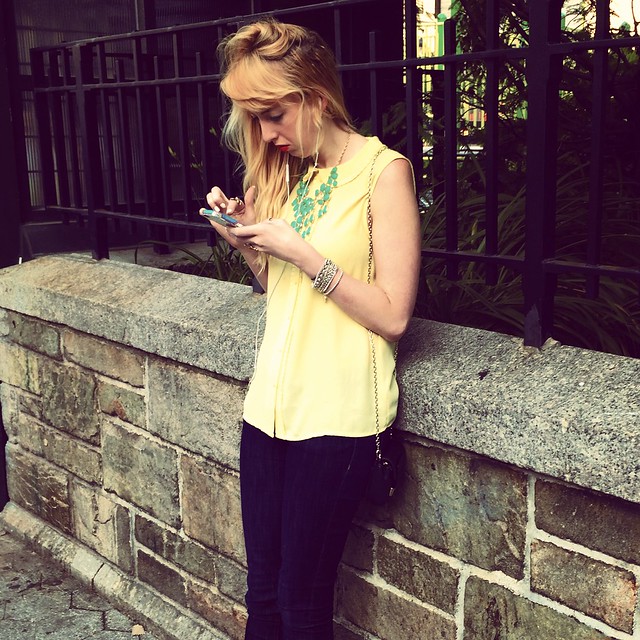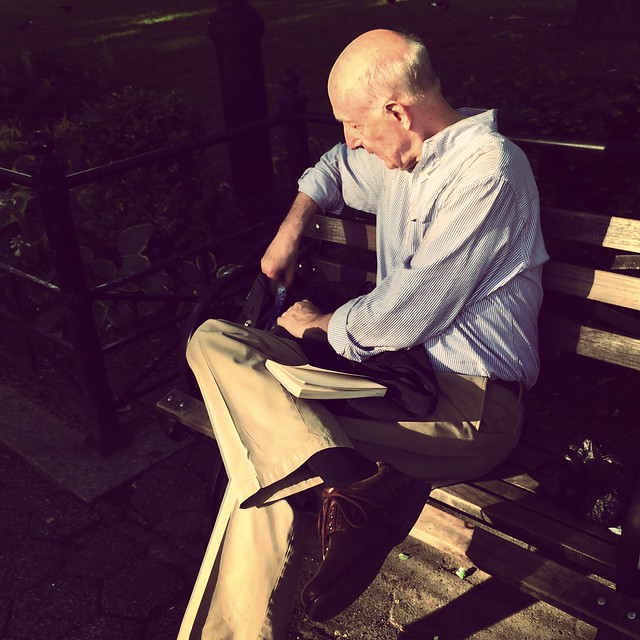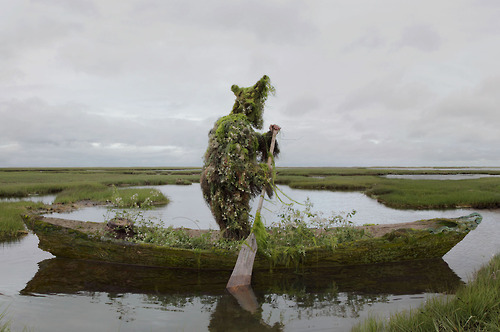 "Greenman," Kahn and Selesnick, All rights reserved
"Greenman," Kahn and Selesnick, All rights reserved
“Truppe Fledermaus & the Carnival at the End of the
World,” at Yancey Richardson, might be described as a performance of the
imagination. Concocted by two English-born, U.S. educated artists, Nicholas Kahn
and Richard Selesnick , the show creates just enough semi-plausible historical
authenticity to soften up viewers for the artists’ outlandish – but not
impossible – vision of the future.
Kahn and Selesnick have collaborated before – for the past 20
years in fact – creating fictitious histories from both the past and future (on
both Earth and other planets) that
combine impeccable pseudo-erudition with no-limits weirdness. I have to
admit I’ve never seen anything quite like this work. The artists’ mastery of
photography, drawing, printmaking, sculpture and creative writing is matched
only by their showmen’s fervor to wow their audience. In fact, trying to think
of comparisons, I could only come up with the Monty Python Flying Circus –likewise
fervently theatrical, over-educated, British and willing to try anything.
These guys are having fun.
 "Der Letztze Mann," Kahn and Selesnick, All rights reserved
"Der Letztze Mann," Kahn and Selesnick, All rights reserved
The world conjured by this show is framed by an invented
traveling theater of hustlers, freaks and spiritualists called “Truppe
Fledermaus” (Bat Troupe). Next to the gallery entrance, an entire wall is covered with posters and handbills advertising the
Truppe’s strange offerings. Stylistically, these ads -- with copy in
German – refer to everything from German Expressionist cinema -- “Ich bin Nosferatu” (I am the Vampyre)
-- to fanciful medical charts – “Tod Frucht” (Death Fruit) – to a colorful, full-figured
nude woman covered with roses that suggests P.T. Barnum via Manet -- “Das Tatowierte Wunder” (The
Tattooed Wonder).
I’m not entirely sure why these ads are funny, but they made
me laugh. The artists’ decision to
use the German language is part of it.
If you’re a linguistically unsophisticated American (like most of us)
try booming out “Ich bin Nosferatu!” over and over in a small room and you’ll
know why. This prejudice is unfortunate and probably worse than that (I
remember my parents telling me about neighbors who refused to take Hitler
seriously because his speeches on the radio made them laugh). But, here, as
elsewhere in the show, Kahn and Selsenick seem determined to go with their guts.
Funny is funny. I’m sure John Cleese would approve.
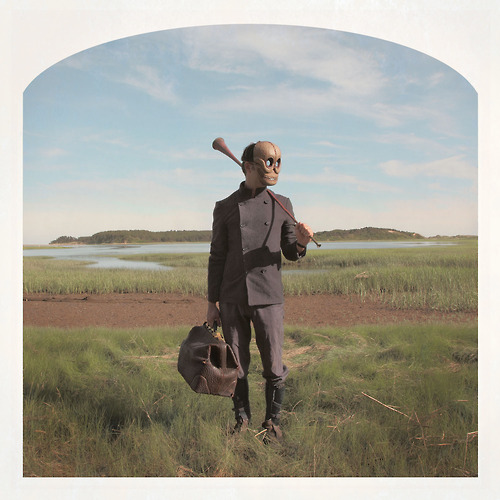
"Demon man," Kahn and Selesnick, All rights reserved
In the room with the prints are a few sculptures – created, we
are told, from “…ceramic, wax, Styrofoam, paint, plaster, glass antlers and
silicone caterpillars.” Like the posters, the sculptures suggest a new world in
which genetic boundaries are exotically shifting. For instance, a bust of a
top-hatted man mounted on a tripod is densely covered with pitch black
feathers, as though he is morphing toward a new consciousness as a crow. By now, it’s clear this theme
will repeat throughout the show. Still, with the tangible three-dimensionality of the sculptures, the idea gains a special
kind of fetishistic power. I’m
guessing many people wouldn’t want this Crow Man to spend the night in their
bedroom.
The remainder of the show (five walls out of six) consists
of photographs. Taken in both black and white and color with an 8 X 10 view
camera, many of these are aesthetically superb (Kahn and Selesnick studied
photography together at Washington University). Their technical control makes
them wonderfully incongruous with the subject matter, which is primitive and
truly bizarre. It’s not clear if
the Truppe Fledermausers themselves are taking part in the activities or simply
witnessing them. “At the end of the world” I’m not sure it matters.
Human populations have collapsed. Individuals and small
groups of humans make their way on foot, by hand-drawn primitive wagons and
carts or in rough canoes, through a bleak, boggy, apparently drowning world of
rampant vegetation and mutant creatures. When they gather in groups it seems to be for the purpose of
creating strange tableux or engaging in wild revels of unclear purpose.
Nearly everyone wears a mask. From Hieronymous Bosch alone, the
artists have stolen bird beaked, owl-eared and wide-eyed grinning demon masks. Furry
bat (fledermaus) masks are also popular and, in a pinch, simple Ku Klux
Klan-style bags with cut-out eyeholes, pulled down over the face, will do.
It’s a wild, wild world.
Climate change and rising sea levels are clearly the subtext here, although the artists’ invented future has little in common with what we might expect from a real post-warming planet. Instead of huge ruins and the ubiquitous trash of billions (whether or not killed off by plagues) -- we get deserted swamps, bogs, mudflats, dunes, beaches, rocky outlooks and placid bodies of water.
Apparently, we are returning forward to a world of harsh threats and magical remedies. In this world even the most basic technologies of the past have been erased. In response Nature Herself seems to be trying something new. Parts are somehow being swapped among humans, other mammals, birds, fish and plants to produce bizarre human-other and other-other hybrids. Among the shambling-bramble-plant-human mixes alone, for example, we see Yew Man, Lichen Man, Seaweed Man and the more generic Greenman, who starred in an earlier Kahn and Selesnick show, “The Pavilion of the Greenman,” in 1997.
All this may not convince as dystopia, but it thoroughly seduces as pure imagination.
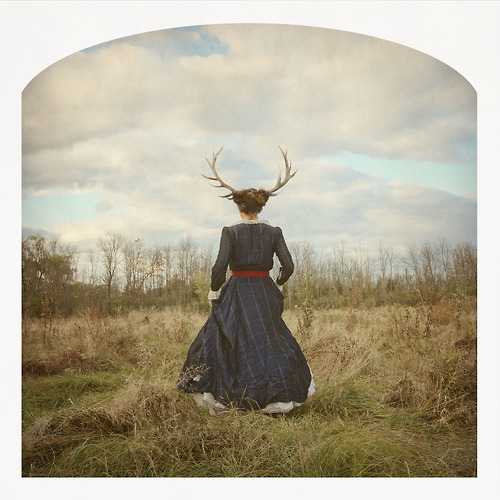
"Lady with antlers," Kahn and Selesnick, All rights reserved
I’ll end this review by describing two favorite pictures. Both represent what to me made this show so unusual -- its willingness to go anywhere imagination might take it. We get jokes and parodies, horror and tragedy, winks and warnings, all blended into visual stories that range from dadaesque to heartwarming.
One: A young woman in Victorian dress is running away,
across a drab, wintry field, holding up her petticoats. From her piled-up hair two giant antlers
rise against the sky. I can feel this woman’s distress. Suddenly, I realize it’s Jane Eyre
fleeing in tears from Mr. Rochester. I become a cynical English
Lord in love. My legs are twitching to follow.
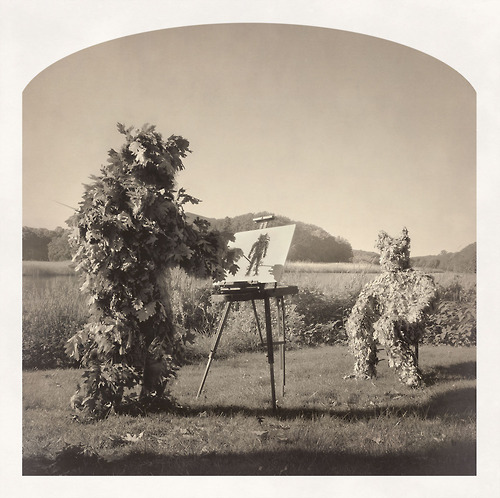
"Leaf man painting Leaf man," Kahn and Selesnick, All rights reserved
Two:
Next to a
curving river, Leaf Man, the artist, sights over his brush at the
plein air portrait of his friend and subject, another Leaf Man. The
two Leaf Men appear to be having a jolly chat. What a pleasant way to make art, they are
saying.
Long live art! How do you say that in German?
This review also appears in The New York Photo Review.

